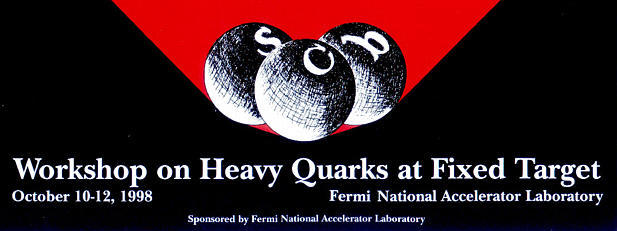
Poster Session Abstracts
Charm Production at NuTeV
Drew Alton and Max Goncharov, Kansas State University
The NuTeV Experiment at Fermilab used a sign-selected beam to generate
either neutrinos or anti-neutrinos with a wrong-sign background
contamination of 10$^{-3}$. During the 1996-97 run NuTeV
recorded over a million charged current events.
The charm sea may be measured using events in which the wrong sign
of muon is detected. The high purity and statistics of this experiment
also allows us to extract the strange sea parameters from opposite
sign dimuon events.
KTEV (E799/E832) - CP Violation and Rare Neutral Kaon Decays
Ram Ben-David, Fermi National Accelerator Laboratory
Search for New Physics in D+/- -> Ks0 X+/- and D+/- -> Ks0 Ks0 K+/-
Harry J. Lipkin(*), Weizmann Institute of Science, Rehovot, Israel;
School of Physics and Astronomy, Raymond and Beverly Sackler Faculty of
Exact Sciences, Tel Aviv University;
Argonne National Laboratory
Direct CP violation beyond the standard model can be produced in charged D
decays to final states with a $K_S$ by small new physics contributions to
the transitions $D^+ \rightarrow K^0 X^+$, where $X^+$ denotes any positively
charged hadronic state or transitions $D^+ \rightarrow K^0 \bar K^0 K^{(*)+}$,
where $K^{(*)+}$ denotes any positive strange state.
These transitions are doubly-Cabibbo suppressed and
color suppresed in the standard model and branching ratios are experimentally
observed to be suppressed by two orders of magnitude relative to the allowed
$D^+ \rightarrow \bar K^0 X^+$ or $D^+ \rightarrow \bar K^0 \bar K^0
K^{(*)+}$, branching ratio. An even smaller new physics contribution might
produce an
observable CP asymmetry in
$D^\pm \rightarrow K_S X^\pm$ or $D^{\pm} \rightarrow K_S K_S K^{(*)\pm}$
decays. Since such asymmetries are easily checked in the early stages of any
charm production experiment, it seems worth while to
check them before the opportunity is lost in later stages of the analysis,
even if no theoretical model predicts such an asymmetry.
(*) Supported in part by The German-Israeli Foundation for Scientific Research
and Development (GIF) and by the U.S. Department
of Energy, Division of High Energy Physics, Contract W-31-109-ENG-38.
Charm Production and Fragmentation in Charged Current DIS
Stefan Kretzer, University of Dortmund, Germany
In charged current deep inelastic scattering charm is dominantly produced
in scattering events on strange quarks, thereby allowing for an experimental
determination of the nucleon's strange sea density. A measurement of the energy
spectrum of final state charm fragments (D-mesons) determines the charm
fragmentation function at spacelike scales considerably below typical
e^+e^- c.m.s. energies. We have calculated NLO corrections to the naive s->c
parton model production picture. The latter stem from W^*g->cbar{s} boson
gluon fusion, W^*s->cg real gluon emission and from virtual corrections to
s->c. They are numerically important and well understood.
Radiative Leptonic B_c Decays in Effective Field Theory
Alexey A. Petrov, Johns Hopkins University
Recent discovery of B_c meson by CDF collaboration
and proposed new experiments at FNAL and CERN call
for extensive theoretical studies of B_c mesons.
Here we investigate the possibility of measuring
B_c decay constant in radiative leptonic decays within
the framework of an effective field theory formulated for
non-relativistic quarks, the NRQCD. We calculate the width
and the photon energy spectrum and comment on the role of
excited vector B_c states.
SELEX (E781) - The Large X Charm Baryon Experiment
Erik Ramberg, Fermi National Accelerator Laboratory
E791 - Charm production and decay at TPL
Kevin Stenson, University of Wisconsin
The E791 experiment used a 500 GeV pion beam on a nuclear
target at the Tagged Photon Laboratory (Fermilab) to
investigate the physics of charm production and decay.
During six months of running in 1991, the E791 experiment
wrote 20 billion events to tape. Recent results from this
data sample are presented. These results include limits
on D0-D0bar mixing and CP violation, semileptonic form
factor and branching ratio measurements and hadronic decay
substructure analyses.
Some spin effects in heavy quarkonia production at fixed target
Avtandil Tkabladze, DESY-IfH Zeuthen, Germany
We discuss the double spin asymmetries in charmonium
states hadroproduction with non-zero transverse momenta at
fixed target energies, $\sqrt{s}\simeq40$ GeV, within the framework of the
factorization approach. It is shown that observation of oppsite sign
double spin asymmetries will allow to distinguish between
Nonrelativistic QCD (NRQCD) factorization approach and color evaporation
model (CEM), two different mechanisms of heavy quarkonium production.
The production of $\Upsilon$ mesons at fixed target energies is
considered. It is shown that Nonrelativistic QCD (NRQCD) predicts
$\Upsilon$ production at fixed target energies with sizeable transverse
polarization. The posibility of observation of $\Upsilon$ polarization at
HERA-B experiment are considered.
FOCUS (E831) - Fermilab High Statistics Charm Experiment
Cecilia Uribe, Physics Institute (IFUAP), Mexico
Marco Reyes, University of California, Davis
FOCUS is a high statistics Charm experiment located in the Fermilab
Wide Band Photon Beam. It is an upgrade of the E687 spectrometer and
during the 1996-1997 Fermilab Fixed Target run, the FOCUS collaboration
collected over 15 times the Charm statistics of E687 and in particular
will have over 25 times the statistics of E687 in semileptonic Charm
decays. This means FOCUS should achieve its goal of 1 million fully
reconstructed Charm decays. The status of the reconstruction and analyses
will be presented. The event reconstruction of the 6.5 billion events
is over 95% complete. Physics skims/stripping is in progress.
Page maintained by
H.
Cheung
Last Revised: October 1, 1998
URL: http://www.fnal.gov/projects/hq98/html/poster_abs.html
title: HQ98 Poster Session Abstracts

